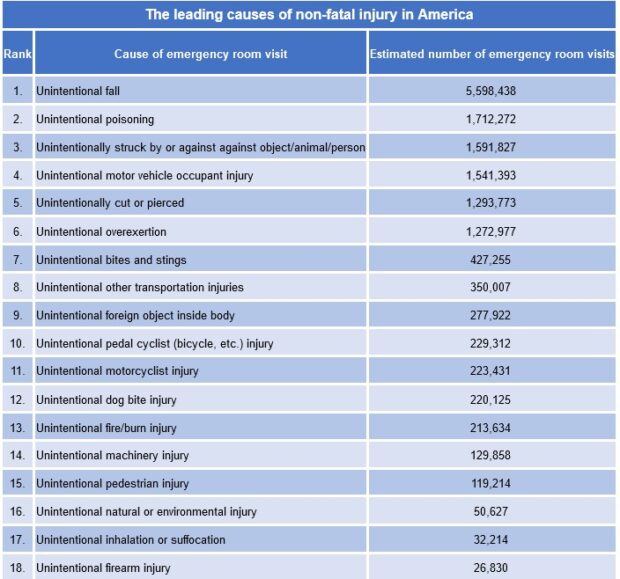A new study highlights the non-fatal injuries that frequently land Americans in the emergency room, with accidental falls topping the list. Unintentional firearm incidents are the least common, accounting for only 26,830 emergency room visits.
The analysis by personal injury attorneys John Foy & Associates used the latest data from the Centers for Disease Control and Prevention (CDC) to uncover the leading injuries that result in emergency room visits.
Unintentional falls are the leading cause of non-fatal injuries in the U.S., resulting in around 5,598,438 ER visits annually across all genders and ages. This type of accident may occur due to circumstances like slippery, cluttered or unstable walking/working surfaces.
Unintentional poisoning came in second, with around 1,712,272 individuals affected each year. This category excludes unexpected adverse effects of correctly administered drugs and bacterial illnesses like food poisoning.
Unintentionally struck by or against rounds out the top three, accounting for 1,591,827 visits each year. Incidents usually involve individuals struck by an object, animal or person, rather than a vehicle or machinery. They can occur in a number of circumstances, such as at a person’s workplace, while walking their dog or while rollerblading on the beach.
Non-fatal injuries involving motor vehicles came in fourth, with an estimated 1,541,393 visits each year. These accidents affect occupants of cars, pickup trucks, SUVs, vans, heavy transport vehicles and buses, and most commonly occur as a result of traffic accidents.
Unintentionally cut or pierced is the fifth most common reason for an emergency room visit, accounting for an estimated 1,293,773 visits each year. Accidental incisions, slashes, perforations, punctures and lacerations from household or occupational objects are common examples of this non-fatal injury.
The sixth-leading cause is overexertion, resulting from activities like heavy lifting or intense workouts. They account for more than 1,272,977 yearly emergency department visits.
Coming in seventh are unintentional bites and stings, causing around 427,255 emergency visits. These include injuries from snake and lizard bites, as well as stings from bees, wasps, scorpions and even jellyfish. This also encompasses injuries involving penetration of the skin from plants.
Other unintentional transportation-related injuries come in eighth, with about 350,007 cases each year. These injuries include pedestrians injured while boarding transport, accidents involving power scooters, go-karts, streetcars and even space transport.
Presence of a foreign body is the ninth leading cause, with around 277,922 yearly incidents. Such incidents could involve accidental ingestion or insertion of foreign objects, such as toys, pebbles or dirt into the eye or other orifices of the body.
Rounding off the top 10 is unintentional pedal cyclist injuries, with 229,312 incidents. This includes accidents involving bicycles and similar transport modes, such as losing control, colliding or other traffic-related events on public roads.

“The data provided further important insights, when looking at sex differences between male and female ER visits,” said John Foy, founder of John Foy & Associates. “For instance, women are more frequently victims of dog bites than men, which could be in part due to the fact that more than 70 percent of dog walkers are female.”
The data indicates occupants of larger vehicles, such as cars, trucks or buses, are 590 percent more likely to sustain non-fatal injuries than motorcyclists, he added.
“It’s also noteworthy that overexertion alone results in more emergency room trips than dog bites, pedal cycle incidents, and bites and stings combined.”





















 The Future of Knowledge in Insurance: From Training to AI-Powered Productivity
The Future of Knowledge in Insurance: From Training to AI-Powered Productivity  Artificial Intelligence Is Rewriting the Rules for Commercial Lines
Artificial Intelligence Is Rewriting the Rules for Commercial Lines  A Practical Blueprint: The Five Plays of an Innovation Culture
A Practical Blueprint: The Five Plays of an Innovation Culture  Rebuilding Negotiation Talent: Why This Skill Is Missing and How to Fix It
Rebuilding Negotiation Talent: Why This Skill Is Missing and How to Fix It 